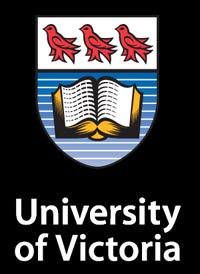Shkotovo and the Partisan Movement
Resentment towards the Allied occupation of Vladivostok fuelled a robust partisan insurgency. This extended beyond the Bolsheviks who had led the short-lived Soviet, to include peasants outraged over the exercise of White power in the Russian Far East. Partisan bands formed spontaneously, but over time coalesced into an effective army fighting alongside Bolsheviks and the Red Army. To curb resistance, the Allies conducted surveillance of dissidents and established an international military police force in Vladivostok, which included six members of Canada’s advance party.
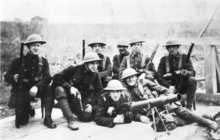
Sidney Rodger Collection, Beamsville, Ontario
Canadian “Lewis Gun” team from "A" Company, 259th Btn, deployed with the inter-Allied force to Shkotovo, April 1919. Rfn. Sidney Rodger is in the centre of the photograph holding the gun.
View more photos like this in the archive
These forces were ill-suited for the irregular guerrilla campaign waged by partisans in Vladivostok and the surrounding taiga (forest). In the spring of 1919, as Allied commanders prepared for a popular insurrection in Vladivostok and the partisan movement surged in the countryside, the Canadians saw the closest thing to combat: the short-lived deployment to the town of Shkotovo, where partisans under the command of farmer Gavrila Shevchenko threatened the Allies’ coal supply on the Suchan River.
PROFILE
Sidney Rodger, Gavrila Shevchenko and the Red Partisans, Spring 1919
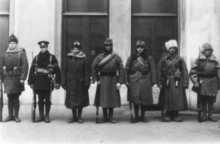
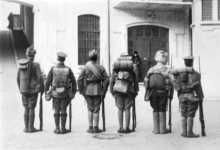
Sidney Rodger Collection, Beamsville, Ontario
The inter-Allied force deployed to Shkotovo, April 1919. Two hundred Canadians joined Japanese, Czechoslovak, Italian, and French troops to repel a partisan attack that threatened the coal supply for Vladivostok and the Trans-Siberian Railroad. When they reached the town, the partisans had retreated and the Canadians were recalled to Vladivostok.
View more photos like this in the archive
“All the Allied troops assembled opposite the officers quarters and it was a most interesting sight to see the six Allies drawn up together to advance on the enemy.”
— Capt. Erik Elkington's diary, describing the inter-Allied force’s departure from Shkotovo to the village of Novorossiskaya early on the morning of 19 April 1919.1
In Vladivostok and the surrounding hill villages, a partisan movement grew and flourished during the winter of 1918-1919. Paralleling social pressures in Canada, compulsory military service drove a wedge between the population of Primorski region and the White Russian government of Admiral Aleksandr Kolchak, based in the Siberian capital of Omsk. Rural inhabitants — farmers like Gavrila Schevchenko — were outraged by White atrocities and foreign occupation of Vladivostok.
They joined irregular partisan units to defend themselves from Kolchak’s soldiers, who marched into their villages and seized peasant youth for the admiral’s New Siberian Army, employing torture to obtain recruits. Motivated by local conditions, the rural inhabitants and city-dwellers moved closer toward Bolshevism.
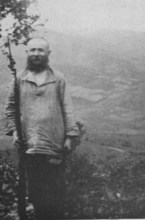
Albert Rhys Williams, Through the Russian Revolution (New York: Boni and Liveright, 1921)
"One of the terrible Red Guards," wrote American journalist Albert Rhys Williams, who was in Vladivostok when the Allies toppled the local Soviet. "I spent several days with this band of 700 peasants fighting against the Whites 'For Land and Freedom.'"
View more photos like this in the archive
By the spring of 1919, the partisan movement launched an offensive to reclaim White and Allied-held territory, waging a guerilla war and seizing the villages of Novorossiskaya, Vladimiro-Aleksandrovskoye, and Olga up the coast (show Map). They repulsed British warships that attempted to land White Russian troops at the mouth of the Suchan River (which is today aptly called Partizansk).
After the White Russian governor imprisoned Vladivostok’s mayor, who was anti-monarchist but not a Bolshevik, the local population was inflamed. Canadian General James H. Elmsley warned Ottawa of an “attempted revolution” and stated there was “no unity of policy or command” among the Allied forces in the port city. Instructions were issued to all Canadian units to suppress “riotous disturbances,” with the cavalry squadron of the Royal North West Mounted Police (RWNMP) instructed to occupy the height of land behind the Canadian headquarters, as marines on the British cruiser HMS Kent prepared to land ashore.
In April 1919, partisans seized the nearby town of Shkotovo, fifty kilometres to the northeast, severing Vladivostok from its coal supply and cutting fuel to the Trans-Siberian Railroad, the Allies' communication lifeline. Two hundred Canadians — including Rifleman Sidney Rodger, a Toronto stock-keeper in the 259th Battalion — rushed to Shkotovo, where they joined Japanese, Chinese, Czecho-Slovak, French, and Italian troops in repelling the partisan advance.
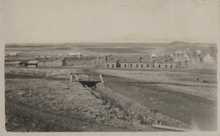
Eric Elkington Collection, Ladysmith, British Columbia
Barracks and surrounding countryside at Shkotovo, looking south toward Ussuriiski Bay. Two hundred Canadians joined an inter-Allied force of 1,000 troops to repel a partisan attack in April 1919.
View more photos like this in the archive
Show me the view today
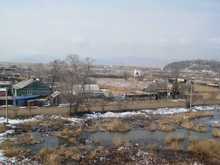
The guerilla fighters retreated to the hills as the Canadians approached the town. In the heat of the Shkotovo operation, Gavrila Schevchenko — the Primorsky farmer and Commander of Partisan Detachments — issued a defiant proclamation to the Allies:
“We demand that you evacuate our territory and go back from where you came …. Just as the Allied troops left Odessa and Archangel, so also you will be forced to leave Vladivostok. Until that time we will never lay down our arms.” 2
Intriguingly, Rfn. Sidney Rodger recorded this defiant enemy statement, word for word, in his diary.
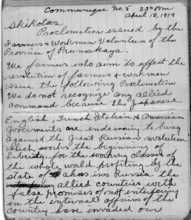
Sidney Rodger Collection, Beamsville, Ontario
Sidney Rodger's diary entry from Shkotovo, a verbatim transcript of the partisan proclamation.
View more photos like this in the archive
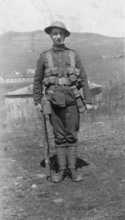
Sidney Rodger Collection, Beamsville, Ontario
Sidney Rodger in his infantryman's gear, 1919.
View more photos like this in the archive
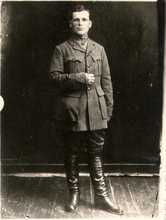
V.K. Arseniev State Museum of Primorsky Region, Vladivostok, Russia
Gavrila Matveevich Shevchenko, commander of partisan detachments in Primorsky (Maritime region), c. 1920. Shevchenko commanded partisan operations against the Allies and White Russians near Shkotovo in April 1919.
View more photos like this in the archive
The confidence of the partisan movement demonstrated the Allies' waning fortunes in the Russian Far East. Rfn. Sidney Rodger and the multi-national force of 1,000 troops completed a futile 20-kilometre march from Shkotovo to the village of Novorossiya, only to find that the partisans had evaporated into the hills — symptomatic of the irregular guerilla warfare in eastern Russia.
They marched back to Shkotovo the same day, where the Japanese commander rewarded the officers with a lavish banquet and the enlisted men with 96 bottles of wine, 18 bottles of whisky and three casks of sake.
“It is really rather remarkable that, at this stage of the proceedings, there should be an insurgent force 30 miles ... this side of Vladivostok,” Major-General Elmsley informed Canada's minister of militia and defence.3
The short-lived Shkotovo operation highlights the Canadians' vulnerable position in and around Vladivostok, and the confidence and motivations behind the partisan insurgency. It helps to demonstrate the factors that contributed to the evacuation of Canadian and Allied forces — and the ultimate Soviet victory — in Siberia and the Russian Far East.
Notes
- 1 Capt. Eric Henry William Elkington diary, n.d. (c. January 1919), p. 2, E.H.W. Elkington Family Collection (private collection), Ladysmith, BC.
- 2 Communique No. 5, 18 April 1919, Library and Archives Canada, War Diary, 16th Infantry Brigade CEF(S), April 1919, appendix. 15.
- 3 Elmsley to Mewburn, 1 May 1919, Library and Archives Canada, RG 24, ser. C-1-A, vol. 2557, file HQC-2514 (vol. 2), “Situation in Russia – Allied Intervention in Russia.”
Go to
Shkotovo et le mouvement des partisans
Le ressentiment contre l'occupation Alliées de Vladivostok alimenta une insurrection partisane vigoureuse. L'insurrection transcenda les Bolchéviks qui avaient dirigés l'éphémère Soviet, et compris des paysans indignés par l'exercice du pouvoir Blanc en Extrême-Orient russe. Des bandes de partisans se formèrent spontanément, et au fil du temps se fusionnèrent en armée efficace qui se combattirent aux côtés des Bolchéviks et l'Armée Rouge. Pour contré la résistance, les Alliés surveillèrent les dissidents et créèrent à Vladivostok une force de police militaire internationale, qui inclut six canadiens.

Collection Sidney Rodger, Beamsville, Ontario
Équipe canadienne « Lewis Gun » de la Compagnie A, 259e Btn, déployé avec la force Interalliée à Shkotovo, avril 1919. Rfn. Sidney Rodger est au centre de la photo tenant son fusil.
Voir d'autres photos semblables dans l'archive
Ces forces étaient guère adaptées pour les attaques guérilla menée par les partisans dans Vladivostok et la forêt Taïga. Au printemps de 1919, lorsque le commandement Alliés se prépara pour une insurrection populaire à Vladivostok et le mouvement des partisans augmentèrent dans les campagnes, les Canadiens se rapprochèrent du combat: un déploiement à courte durée dans la ville de Shkotovo, où des partisans sous le commandement de l'agriculteur Gavrila Shevchenko menacèrent une source indispensable de charbon Alliés sur la rivière Suchan.
PROFIL
Sidney Rodger, Gavrila Shevchenko et les partisans Rouges, printemps 1919


Collection Sidney Rodger, Beamsville, Ontario
La force Interalliée déployé pour Shkotovo, avril 1919. Deux cents Canadiens se joignirent aux troupes japonaises, tchécoslovaques, italiennes et françaises pour repousser une attaque partisane qui menaçait une source importante de charbon de Vladivostok et du Chemin de Fer Transsibérien. Quand ils arrivèrent à la ville, les partisans s'étaient déjà retirés et les Canadiens furent rappelés à Vladivostok.
Voir d'autres photos semblables dans l'archive
« Toutes les troupes Alliées se sont assemblées en face du quartiers d'officiers et c'était très intéressant de voir les six Alliés s'avancer ensemble contre l'ennemi ».
— Le journal du Capitaine Eric Elkington, décrivant le départ de la force Interalliée de Shkotovo au village de Novorossiskaya tôt le matin du 19 avril 1919.1
À Vladivostok et les villages environnants, le mouvement partisan grandi et prospéra pendant l'hiver de 1918-1919. Comparable à la pression sociale au Canada, le service militaire obligatoire aliéna la population de Primorsky Krai et du gouvernement Blanc russe de l'Amiral Alexandre Vassilievitch Koltchak, installé dans la capitale sibérienne d'Omsk. Les habitants — des agriculteurs comme Gavrila Schevchenko – furent scandalisés par les atrocités Blanches et l'occupation étrangère de Vladivostok.
Ils formèrent des unités irrégulières de partisans pour se défendre contre les soldats de Koltchak, qui marchèrent dans leurs villages et saisissent les jeunes pour l'Armée Nouvelle de la Sibérie (Blanche), et employèrent la torture pour se garantir des recrues. Ainsi motivé par les conditions locales, les habitants ruraux et citadins se rapprochèrent du Bolchévisme.

Albert Rhys Williams, Through the Russian Revolution (New York: Boni and Liveright, 1921)
« L'un des terribles gardes Rouge », écrit le journaliste américain Albert Rhys Williams, qui était à Vladivostok lorsque les Alliés renversèrent le Soviet local. « J'ai passé plusieurs jours avec ce groupe de 700 paysans qui luttaient contre les Blancs pour leurs terres et liberté ».
Voir d'autres photos semblables dans l'archive
Au printemps de 1919, les partisans lancèrent une offensive guérilla pour reconquérir du territoire Blanc et occupé par les Alliés, tels que les villages de Novorossiskaya, Vladimiro-Aleksandrovskoye, et l'Olga jusqu'à la côte (Voir le plan). Ils repoussèrent des navires de guerre britanniques qui tentèrent de débarquer des troupes russes Blanches à l'embouchure de la rivière Suchan (qui est aujourd'hui appelé à juste titre Partizansk).
La population locale fut enflammée à la suite de l'emprisonnement du maire de Vladivostok par le gouverneur russe Blanc, qui était anti-monarchiste sans être Bolchévik. Le Général canadien James H. Elmsley averti Ottawa d'une « révolution tentative » et déclara qu'il n'y avait « pas d'unité politique ou militaire » parmi les forces Alliées dans la ville portuaire. Des instructions furent données à toutes unités canadiennes de supprimer « les perturbations et émeutes », et l'escadre de cavalerie de la Royale Gendarmerie à Cheval du Nord-Ouest (RGCN-O) fut chargé de surveiller les terres haute derrière le quartier général canadien, tandis que des Marines sur le croiseur britannique HMS Kent préparèrent leurs débarquements.
En avril 1919, les partisans s'emparèrent de la ville voisine de Shkotovo, une cinquantaine de kilomètres au nord-est, et rompirent Vladivostok d'une source indispensable de charbon et de carburant pour le Chemin de Fer Transsibérien: en effet la seule la ligne de communication des Alliés. Deux cents Canadiens - y compris le Carabinier Sidney Rodger, un boursier de Toronto du 259e Bataillon - se précipitèrent à Shkotovo, où ils rejoignirent les forces japonaises, chinoises, tchécoslovaques, françaises et italiennes, pour repousser l'offensive partisane.

Collection Eric Elkington, Ladysmith, Colombie-Britannique
Baraquements et campagnes environnantes à Shkotovo, vue du sud vers la Baie d'Ussuriiski. Deux cents Canadiens rejoignirent une force Interalliée de 1000 soldats pour repousser une attaque partisane en avril 1919.
Voir d'autres photos semblables dans l'archive
Que ressemble-t-il aujourd'hui?

Les guérillas se retirèrent dans les collines lorsque les Canadiens s'approchèrent de la ville. Au cours de l'opération Shkotovo, Gavrilo Schevchenko – l'agriculteur de Primorsky et commandant des détachements de partisans — issue une proclamation défiante aux Alliés:
« Nous exigeons que vous évacuez notre territoire et retourner d'où vous venez .... Comme les troupes Alliées quittèrent Odessa et d'Arkhangelsk, vous aussi serez forcé de quitter Vladivostok. Entre temps nous baisserons jamais nos armes ».2
Curieusement, Sidney Rodger enregistra cette déclaration mot pour mot dans son journal.

Collection Sidney Rodger, Beamsville, Ontario
Transcription littérale de la proclamation partisane dans le journal de Sidney Rodger.
Voir d'autres photos semblables dans l'archive

Collection Sidney Rodger, Beamsville, Ontario
Sidney Rodger et son équipage de fantassin, 1919.
Voir d'autres photos semblables dans l'archive

Musée d'État V.K. Arseniev de la région de Primorsky, Vladivostok, en Russie
Gavrila Matveevich Shevchenko, commandant des détachements de partisans dans la région de Primorsky, c. 1920. Shevchenko commanda les opérations partisanes contre les Alliés et les russes Blancs près de Shkotovo en avril 1919.
Voir d'autres photos semblables dans l'archive
L'audace des partisans fut une réflexion de la fortune déclinante de Alliés. Sidney Rodger et la force multinationale de 1000 hommes terminèrent futilement la longue march de 20 kilomètres de Shkotovo au village de Novorossiya, pour constater que les partisans avaient disparus dans les collines d'une manière typique de la guérilla en Russie orientale.
Ils se retournèrent à Shkotovo le même jour, où le commandant japonais récompensa les officiers avec un banquet somptueux et les troupes avec 96 bouteilles de vin, 18 bouteilles de whisky et trois fûts de saké.
« C'est vraiment remarquable qu'à ce stage, il y avait une force insurrectionnelle 30 miles ... de ce côté de Vladivostok », le Major-Général Elmsley informa le Ministre de la Milice et de la Defence.3
L'opération de courte durée à Shkotovo met en évidence les positions canadiennes vulnérables dans et autour de Vladivostok, en plus de l'estime et les motivations de l'insurrection partisane. Elle démontre aussi les facteurs qui contribuèrent à l'évacuation des forces canadiennes et Alliées — et la victoire finale soviétique — en Sibérie et en Extrême-Orient russe.
Notes
- 1 Journal du Capitaine Eric Henry William Elkington, s.d. (c. janvier 1919), p. 2, Collection de famille E.H.W. Elkington (collection privée), Ladysmith, Colombie-Britannique.
- 2 Communiqué n. 5, le 18 avril 1919, Bibliothèque et Archives Canada, Journal de guerre, 16e Brigade d'Infanterie de la FECS, avril 1919, annexe 15.
- 3 Elmsley à Mewburn, le 1er mai 1919, Bibliothèque et Archives Canada, RG 24, sér. C-1-A, vol. 2557, dossier HQC-2514 (vol. 2), « Situation in Russia – Allied Intervention in Russia ».
Sauter à
Шкотово и партизанское движение
Возмущение союзнической интервенцией и оккупацией Владивостока переросло в сильное партизанское движение. Оно выходило за рамки власти большевиков, которая недолго длилась в регионе; партизанское движение представляло собой объединение крестьян, возмущенных карательными методами белых на Дальнем Востоке России. Партизанские банды формировались стихийно, со временем они сливались с эффективной и структурированной Красной армией, воюющей на стороне большевиков. Чтобы обуздать сопротивление, союзники (интервенты прим. переводчика) вели наблюдение за мятежниками, для этого была создана международная военная полиция во Владивостоке, в которую входило шесть канадцев.

Коллекция Сидни Роджера, г. Бимсвилль
Канадская кампания «Льюис Ган» из роты «А» 259-ого батальона совместно союзническими силами была направлена в Шкотово в апреле 1919г. Сидни Роджер в центре фотографии, в его руках ружье.
Больше фотографий в архиве
Эти силы были плохо приспособлены для борьбы с нерегулярными вылазками партизан во Владивостоке и окрестной тайге. Весной 1919г. союзническое командование было готово к народному восстанию во Владивостоке и к партизанскому движению в крае. Ближайшее место для нанесения удара по партизанам было выбрано в селе Шкотово, где партизаны под командованием крестьянина Гаврилы Шевченко являлись угрозой для поставок угля из долины реки Сучан (ныне река Партизанская).
Очерк
Сидни Роджер, Гаврила Шевченко и Красные партизаны, весна 1919г.


Коллекция Сидни Роджера, г. Бимсвилль, Канада
Многонациональные союзнические силы в Шкотово, апрель 1919г. Двести канадцев присоединились к японским, чехословацким, итальянских и французским военным силам, чтобы отразить партизанские атаки, которые угрожали угольным поставкам во Владивосток и всей транссибирской железной дороге. Когда союзники заняли город, партизаны отступили, и канадцы были отозваны назад во Владивосток.
Больше фотографий в архиве
«Все союзнические войска собрались напротив офицерских казарм, -это было настоящем зрелищем смотреть, как все они вместе шли на врага».
— из дневника Эрика Элкингтона, где описывается отправка союзнических войск со Шкотово в деревню Новороссия ранним утром 19 апреля 1919г. 1
Во Владивостоке и прилегающих деревнях на сопках партизанское движение росло и процветало в течение зимы 1918-1919г. Параллельно с социальной напряженностью в Канаде, военное постановление об обязательной воинской повинности прорубило клин между населением Приморского края и правительством А. Колчака в Омске. Сельские жители, среди которых крестьянин Гаврила Шевченко, были возмущены белым террором и иностранной оккупацией Владивостока.
Они вступали в нерегулярные партизанские отряды, чтобы защитить крестьянскую молодежь в своих деревнях от колчаковских солдат, что набирали Новую сибирскую армию, используя пытки для получения новобранцев. Поэтому руководствуясь местными условиями, жители деревень и горожане склонялись ближе к большевизму.

Альберт Рис Уильямс, «Мысли о русской революции» (New York: Boni and Liveright, 1921)
«Один из ужасных красных патрулей», - писал американский журналист Альберт Рис Уильямс, который был во Владивостоке, когда союзники свергли местные Советы: «Я провел несколько дней с бандой из 700 крестьян, сражающихся против белых «за землю и свободу».
Больше фотографий в архиве
К весне 1919г. партизанское движение начало наступление на Белую армию и территорию подконтрольную союзникам, оно проводило подпольную войну с целью захватить деревни Новороссия, Владимиро-Александровское и село Ольга (см. карту). Они дали отпор британскому военному кораблю, что пробовал выгрузить на берег армию Белых в районе устья реки Сучан (ныне р. Партизанская).
После того, как белый губернатор заключил в тюрьму главу Владивостока, который был анти монархистом, но не большевиком, местное население было на грани взрыва. Канадский генерал Джеймс Элмслей предупредил Оттаву о «попытке революции» в городе, а также об «отсутствие единства в политике и командование» между союзническими войсками во Владивостоке. Были изданы соответствующие инструкции для всех канадских частей о подавление «буйных беспорядков» силами Королевской северо-западной конной полиции, которым надлежало в случае возникновения таковых занять высоты вокруг канадского военного штаба (за Пушкинским театром находится сопка «Орлиное гнездо», прим. перевод.) одновременно с высадкой морских пехотинцев британского крейсера «Кент» на берег.
В апреле 1919г. партизаны захватили село Шкотово, пятьдесят километров к северо-востоку от Владивостока, тем самым перерезав поставки угля в город, поставив под угрозу жизненно важные для союзников коммуникации вдоль транссибирской железной дороге. Двести канадцев, включая стрелка Сидни Роджера, совершили марш бросок в Шкотово, где присоединились к японским, чехословацким, французским и итальянским частям, с целью опережения партизанского наступления.


Партизаны отступили в горы, когда канадцы подошли к селу. В самый разгар операции в Шкотово, Гаврило Шевченко, командир партизанского отряда, направил декларацию к интервентам:
«Мы требуем, чтобы вы увели свои войска с нашей территории туда, от куда они пришли… Точно так же как войска интервентов покинули Одессу и Архангельск, так и вы будете вынуждены покинуть Владивосток. До того момента мы не сложим наше оружие».2
Интересно то, что стрелок Сидни Роджер записал слово в слово декларацию Шевченко в своем дневнике.

Коллекция Сидни Роджера, г. Бимсвилль, Канада
Страница дневника Сидни Роджера написанная в Шкотово, дословная передача декларации партизан.
Больше фотографий в архиве

Коллекция Сидни Роджера, г. Бимсвилль, Канада.
Сидни Роджер в своем пехотном обмундирование, 1919г.
Больше фотографий в архиве

Фотография из фондов ПГОМ им. В.К. Арсеньева, г. Владивосток
Гаврила Матвеевич Шевченко, командир партизанского отряда в Приморском крае, фото 1920г. Шевченко командовал партизанскими операциями против интервентов и Белых вблизи Шкотово в апреле 1919г.
Больше фотографий в архиве
Уверенность партизан в своих действиях лишала союзнические силы оптимизма о будущем своей миссии на российском Дальнем Востоке. Сидни Роджер и многонациональные силы из 1000 человек совершили марш бросок в 20 километров со Шкотово в деревню Новороссия, только чтобы убедиться, что партизаны ушли в горы, как они обычно поступали в случае опасности.
В тот же день канадцы вернулись пешком в Шкотово, где японское командование подарило офицерам и всем участникам операции роскошный банкет с 96 бутылками вина, 18 бутылками виски и тремя ящиками саке.
«Что весьма примечательно, так это то, что во время этого разбирательства, мятежнические силы находятся всего в 30 милях от Владивостока» — генерал-майор Элмслей информировал министра милиции и обороны Канады.3
Короткая операция в Шкотово свидетельствует, что Канады находились в весьма уязвимом положении, базируясь в окрестностях Владивостока, а также об уверенной мотивации партизан. Это в очередной раз демонстрирует факторы, способствующие эвакуации канадских и всех союзнических сил, и конечную победу Советов в Сибири и на российском Дальнем Востоке.
Примечания
- 1 Capt. Eric Henry William Elkington diary, n.d. (c. January 1919), p. 2, E.H.W. Elkington Family Collection (private collection), Ladysmith, BC.
- 2 Communique No. 5, 18 April 1919, Library and Archives Canada, War Diary, 16th Infantry Brigade CEF(S), April 1919, appendix. 15.
- 3 Elmsley to Mewburn, 1 May 1919, Library and Archives Canada, RG 24, ser. C-1-A, vol. 2557, file HQC-2514 (vol. 2), “Situation in Russia – Allied Intervention in Russia.”
Перейти к
Research Question
What motivated the partisan insurgency in and around Vladivostok?
Key Themes
- • Civilian responses to the Allied occupation of Primorsky region
- • Relations between the local population and the White Russian governments
- • Inter-Allied cooperation between Canadian, Japanese, Czecho-Slovak, Chinese, Italian and French forces
Question de recherche
Qu'a-t-il motivé l'insurrection partisane dans Vladivostok et son voisinage?
Principaux thèmes
- • Réactions civiles à l'occupation Alliées de Primorsky
- • Relations entre la population locale et les gouvernements de russes Blancs
- • Coopération Interalliée entre les troupes canadiennes, japonaises, tchécoslovaques, chinoises, italiennes et françaises
Исследуемый вопрос
Что мотивировало партизанское движение во Владивостоке и за его пределами?
Ключевые темы
- • Гражданский ответ на союзническую интервенцию в Приморье
- • Взаимоотношения между местным население и белым правительством России
- • Многонациональная союзническая операция канадских, японских, чехословацких, китайских, итальянских и французских военных сил
Maps
Primary Documents
- US Army Intelligence report on White Russian torture (coming soon)
- Capt. Charles Hertzberg's diary on Vladivostok unrest (coming soon)
- Gen. Elmsley's telegram on Allied disunity (coming soon)
- Instructions in Case of Rioutous Disturbances in Vladivostok (coming soon)
- Capt. Eric Elkington diary from Shkotovo
- Rfn. Sidney Rodger diary from Shkotovo (coming soon)
- Proclamation issued by Shevchenko, partisan commander
Multimedia
Photographs from the Digital Archive
- Eric Elkington's photo album from Shkovoto
- Multi-national force deployed to Shkotovo, April 1919
- Canadians boarding a train to Shkotovo
- Japanese officers outside the train
- Lewis Gun team from 'A' company of 259th Battalion
- Rifleman Sidney Rodger
- Do Lin Tsoy, commander of Chinese partisans in Primorsky region
- Kim Pen Ha, commander of Korean partisans in Primorsky region
Plans
Documents primaire
- Rapport du service d'intelligence des E.U. sur la torture en Russie Blanche
- Journal du Capitaine Charles Hertzberg sur les troubles à Vladivostok
- Le télégramme du Général Elmsley discutant la désunion des Alliées
- Instructions au cas de perturbations à Vladivostok
- Journal écrit à Shkotovo du Capitaine Eric Elkington
- Journal de Sidney Rodger de Shkotovo
- Proclamation de Shevchenko, commandant partisan
Multimédia
Photos d'Archives Numériques
- Album photo de Shkovoto d'Eric Elkington
- Force multinationale déployée à Shkotovo, avril 1919
- Canadiens à bord d'un train roulant vers Shkotovo
- Officiers japonais hors du train
- Équipe « Lewis Gun » de la Compagnie A du 259e Bataillon
- Rodger Sidney, Carabinier
- Do Lin Tsoy, commandant des partisans chinois à Primorsky
- Kim Pen Ha, commandant des partisans coréens à Primorsky
Карты
Первичные документы
- Разведывательный доклад США о белом терроре
- Записи дневника капитана Чарльза Хертзбергера о беспорядках во Владивостоке
- Телеграмма ген. Элмслея об отсутствие единства среди союзников
- Инструкция на случай массовых волнений во Владивостоке
- Записи дневника Эрика Элкингтона со Шкотово
- Записи дневника Сидни Роджера со Шкотово
- Декларация Шевченко, лидера партизан Приморья
Мультимедия
Фотографии из цифрового архива
- фотоальбом Э. Элкингтона со Шкотово
- Многонациональные союзнические силы в Шкотово, апрель 1919г.
- Канадцы садятся на поезд до Шкотово
- Японские офицеры у поезда
- Команда Льюиса Гана из роты «А» 259-ого батальона
- Стрелок Сидни Роджер
- До Линь Цой, командир китайских партизан в Приморском
- Ким Пен Ха, командир корейских партизан в Приморском
 English
English Français
Français Русский
Русский
